Bluegrass and Old Time at UCLA
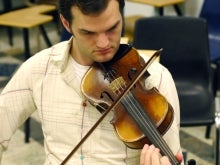
World music performance ensembles have played a key role in the UCLA Department of Ethnomusicology ever since Mantle Hood declared that its students should be bi-musical. Hood meant that researchers should be fluent in both European classical music theory and whatever other musical idiom they studied; fluent not only as thinkers and writers but also as performing musicians. Fifty years later, the idea of bi-musicality has grown more complicated as musicians and scholars have access to numerous diverse musical traditions. Even so, a core principle of the UCLA program remains that musicking is a way of knowing, a form of discourse and of pedagogy.
As a student and teacher in the UCLA Bluegrass and Old Time Ensemble, I’m keenly aware of the challenges and limitations in implementing the idea of bi-musicality. One must find a balance between teaching complete novices and appealing to seasoned insiders; make changes to long-standing musical traditions so that they function as university classes; and navigate the strange, liminal space that the ensembles inhabit between the university bureaucracy and the broader community. Despite these challenges, the world music ensembles are an invaluable asset of the UCLA program and provide a novel opportunity for scholars to perform ethnomusicology.
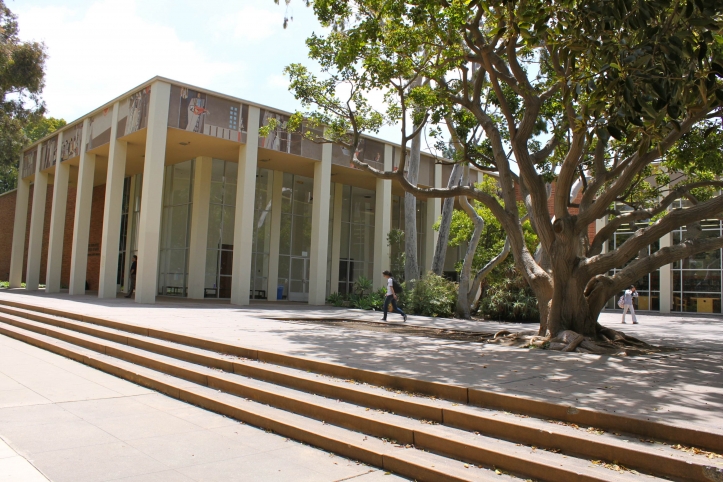
The Herb Alpert School of Music in Schoenberg Hall at UCLA.
As the group’s name indicates, the UCLA Bluegrass and Old Time Ensemble focuses on two related but distinct musics. Old time music generally refers to a rural American roots music that was transmitted aurally amidst families and musicians prior to the rise of recordings and radio. It is especially associated with the mountainous Appalachian region of the American south, though today the old time genre usually encompasses regional folk music styles related more by attitude, mode of transmission, and instrumentation than by specific geographic region. The music centers around the fiddle, with its long pedigree in the British Isles, and the banjo, with its West African family tree. The old time repertoire includes dance tunes, ballads, and unaccompanied field hollers that were passed around by oral tradition or made up on the spot to impress a sweetheart, instigate the audience to cut a rug, or simply pass the time. The American folk music revival in the mid-20th century stimulated abundant interest in old time music around the country, producing new venues and new modes of transmission that have helped maintain lively scenes in city centers and urban areas alike.
Bluegrass music is a horse of a different color, but it’s still a horse.1 It grew from the soil of old time and early country music, adding virtuosic instrumentals and sweetened vocal harmonies ideal for recording, broadcast, and stage shows. It usually features fiddle, mandolin, banjo, guitar, and bass with additional thingamajigs sometimes thrown in to boot. The development of bluegrass’s signature style is usually associated with the creative genius of specific individuals, foremost among them Bill Monroe and his Blue Grass Boys, the Ralph and Carter Stanley Brothers, and Earl Scruggs and Lester Flatts’ Foggy Mountain Boys.
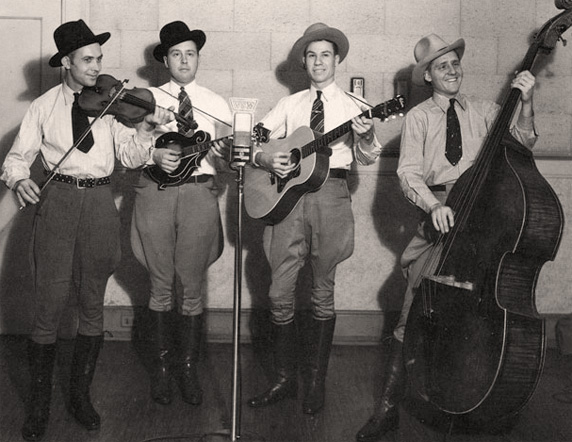
Bill Monroe (second from left) and his Blue Grass Boys in 1939.
The Bluegrass and Old Time Ensemble at UCLA was founded in the 1990s and has continued today despite a series of multi-year hiatuses. Housed in UCLA’s Department of Ethnomusicology, the ensemble has always been driven by the impetus of its students: especially graduate students Michael Harshberger, Amy Corin, and Amy Wooley in the 1990s and undergraduate Tommy Stanton and graduate student Jennie Gubner in the 2000s. In the last five years, the ensemble has particularly benefitted from the guidance of Anthony Seeger, who served as professor of record from 2007 to 2012. I took over coordination of the ensemble in fall of 2011 under the guidance of Professors Helen Rees and Timothy Taylor and have attempted to maintain a delicate balance of collaborative participation, stellar performances, and some measure of “authenticity” in the repertoire, sound, and mode of transmission.
You’ll find the String Band rehearsing in Schoenberg Hall on Tuesday evenings. Ten to fifteen of us sit in a circle of chairs that grows and shrinks as people come in and out. We are armed with fiddles, banjos, mandolins, ukuleles, and an extra-large contingent of acoustic guitars. Fiddle tunes are our staple, with melodies alternatively rollicking and mournful, timbres at once rough and sweet, and rhythms hypnotically straight-ahead or off-kilter and “crooked.” We also sing a handful of lined-out camp spirituals and long-form ballads, adding variety to the repertoire and keeping the guitar players involved as they sometimes weary of the repetitive harmonic cadences and boom-chuck rhythms.
As much as possible, we try to keep the pedagogy in line with the old time tradition. All melodies are taught by ear, and the environment is collaborative in the sense that anyone may teach or lead a tune as long as they can do so competently. Learning melodies and lyrics aurally – and remembering them from week to week – is a piece of musicianship that can be improved through practice like any other. As in the old time tradition, ensemble members sometimes make new lyrics and couplets for the tunes we learn, either written in advance or improvised on the spot. Here are a few old time lyrics freshly made by members of the UCLA Old Time Ensemble (to the tune of “Shady Grove”):
Momma said "Get you a wife" And then you'll be a man But I still feel just like a child When Mary takes my hand | Turnips in the wintertime Tulips in the spring When I get my money made I’ll buy you a diamond ring | If I had a moonshine still I’d fill it up with grain Siphon off the hundred proof And commence to kill my brain |
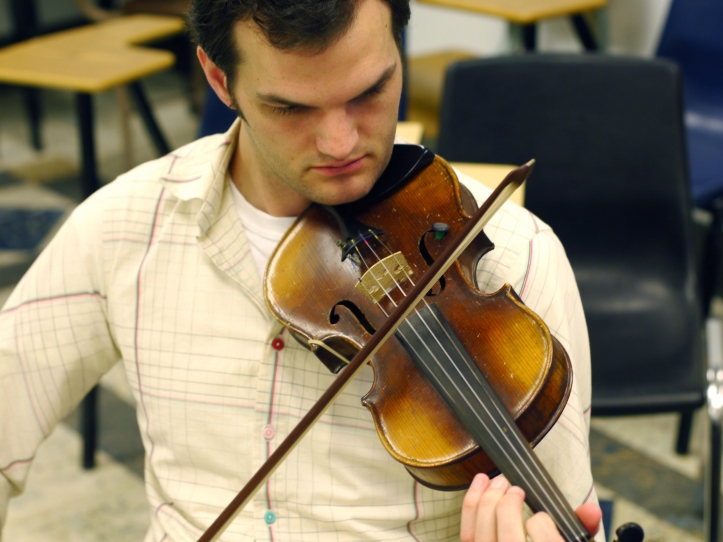
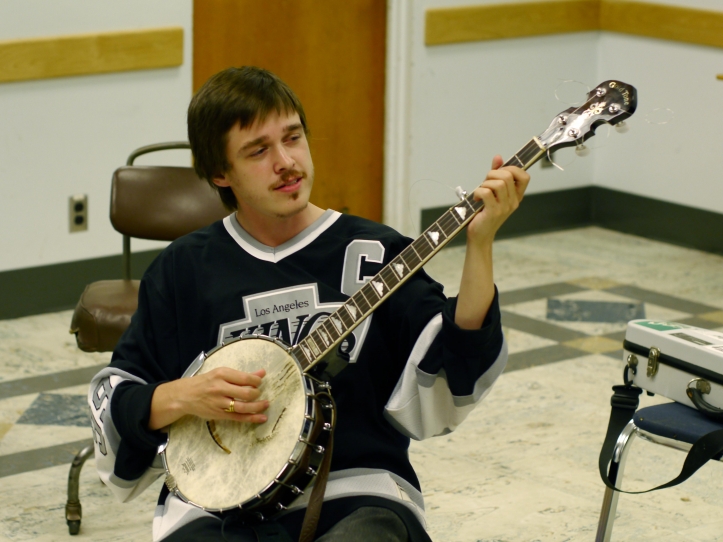
UCLA students Rob Denomme (left) and Wyatt Stone (right) play banjo and fiddle in the UCLA Bluegrass and Old Time Ensemble. Photo: Scott Linford.
All the same, the group does make some compromises to fit the university setting. For longer songs and ballads, we may rely on lyric sheets or even a computer projector to avoid using music stands. Members of the ensemble frequently send emails with links to performances on YouTube or the Digital Library of Appalachia, the present-day equivalent of the scratchy old records that earlier folk revivalists learned from. To encourage active participation from all members of the ensemble, we often choose a traditional lyric to serve as the “chorus” of a particular tune and sing it in unison from time to time, creating a roughly strophic structure that is rare in traditional old time tunes.
After an hour and a half of old time jamming, the group reorganizes into the UCLA Bluegrass Band, otherwise known as the “L.A. BlueGrassHoppers.” This group is smaller than the Old Time Ensemble, with admittance by audition only; and only then when there are vacancies. In contrast to the old time ensemble, which focuses on the simple joy of playing music together, the bluegrass band is oriented towards public performances. This means virtuosic instrumental solos, tight vocal harmonies, and carefully orchestrated arrangements. Accordingly, our rehearsals are filled with (sometimes heated) discussion of arrangements and musical details, and strictly regimented practice sessions before significant performances. In the words of one of the group’s three banjoists, “That’s when Scott gets all authoritarian.”
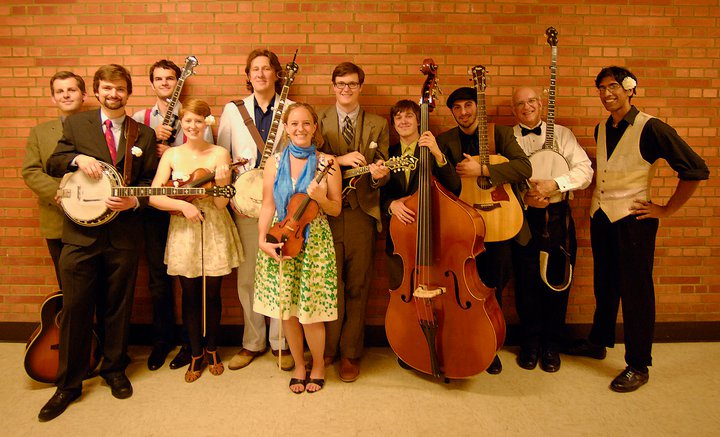
The L.A. BlueGrassHoppers after the Spring Festival of World Music concert at UCLA. From left: Douglas Morier, Tommy Stanton, Rob Denomme, Nicolette Yarbrough, Scott Linford, Jennie Gubner, Joseph Lorge, Wyatt Stone, Cameron Hovspepian, Anthony Seeger, Siddharth Bhaskar. Photo: Allen Stone.
The bluegrass band’s affiliation with the Department of Ethnomusicology yields opportunities for both parties. Taking advantage of the diverse musical milieu, the band has collaborated with several of the other UCLA world music ensembles, including the Chinese, Balkan, and Mexican music ensembles. From time to time, we invite guest performers on Irish tin whistle and concertina, or Indian bansuri and veena. In turn, the bluegrass band represents the department and contributes to the UCLA community through performance at the Chancellor’s Residence, the Dean’s Annual Party, the Arts and Architecture Graduation Ceremony, the Fowler and Hammer Museums, the Topanga Canyon Fiddle and Banjo Festival, the annual campus square dance, and many more. We also collaborated with student technicians at the UCLA School of Film and Television to produce a CD over the last two years, which is now available on CDBaby.
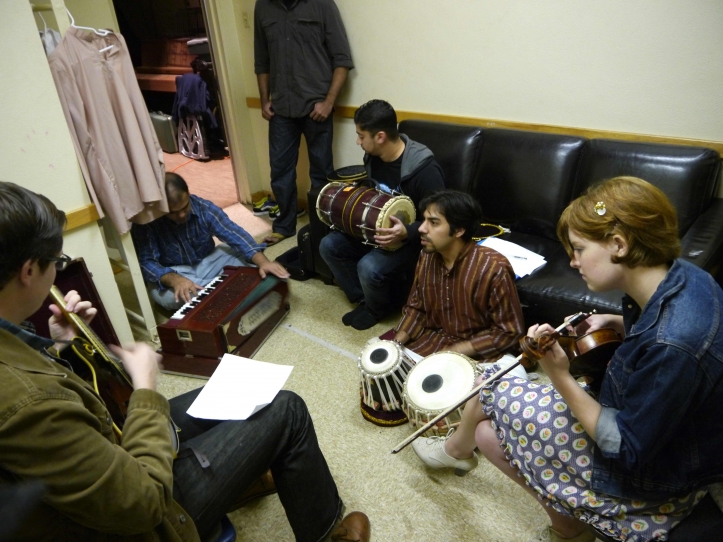
Members of the L.A. BlueGrassHoppers play with Indian musicians at a benefit concert for a local non-profit. From left: Joseph Lorge, Aditya Kalavagunta, Vinay Sharma, Vivek Virani, Nicolette Yarbrough. Photo: Scott Linford.
UCLA students are often surprised to learn that their school includes a credited course called “Bluegrass and Old Time String Band.” I suppose their surprise has something to do with the lingering perception that folk musics are less worthy of study than Western art music, and perhaps also with the common perception that ethnomusicology is about the study of “other” musics and not musics closer to home. (For example, students are sometimes less surprised to find that UCLA has a Balinese gamelan ensemble.) Playing bluegrass and old time music at UCLA enlivens the campus soundscape and enriches student education through the musical way of knowing. And that’s what bi-musicality is all about.
Audio from the L.A. BlueGrassHoppers CD:
- “You Are My Flower” by the L.A. BlueGrassHoppers:
- “Say Darlin’ Say (Mocking Bird)” by the L.A. BlueGrassHoppers, featuring Siddharth Bhaskar on veena:
Video of the L.A. BlueGrassHoppers in concert:
1 Bluegrass and old time musicians don’t always get along, despite their historical and musical links. For a particularly colorful commentary on the difference between old time and bluegrass, see Jeff Titon’s fantastic interactive interview with old time fiddler Clive Davenport. Here’s a preview: “There's just nothing to it. I don't call it music. Just a big racket. A bunch of old guitars a-beating and a-thrashing. Not music.”





